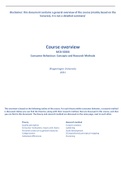Disclaimer: this document contains a general overview of the course (mainly based on the
lectures), it is not a detailed summary!
Course overview
MCB-30306
Consumer Behaviour: Concepts and Research Methods
Wageningen University
2021
This overview is based on the following outline of the course. For each theory within consumer behavior, a research method
is discussed. Below you can find the theories, along with their research method, that are discussed in this course, and that
you can find in this document. The theory and research method are discussed on the same page, next to each other.
Theory Research method
Quality perception Conjoint analysis
Consumer motivation, means-end chains Laddering
Personal construct to general measures Scale development
Categorization (Compositional) perceptual mapping
Individual differences Clustering
, Quality perception Conjoint analysis
Perception is not seeing how the world actually is, but how Conjoint analysis determines or estimates the contribution
the observer sees it. The perception is an approximation of (part worths) of product characteristics (levels of product
reality. A valid perception (what you see is actually how it attributes) to consumer’s overall product perception,
is) requires observational reliability. There are two types of preference or intention to buy. It is used for hypothetical
observational reliability: inter-observer reliability (different products. Respondents rate product profiles, which are
people perceive the same) and intra-observer reliability defined in attributes and attribute levels. The ratings are
(things are perceived similar over time). But observational used to calculate the contribution to the overall preference.
reliability is not a guarantee for validity. These profiles are calibration profiles. Respondents are also
asked to rate holdout profiles. These are not included in the
Minimum requirements for perception are external stimuli, estimation of part worths (the contribution), and can be
sensory receptors, mental processes, and reactions to used to see how well preferences can be predicted.
stimuli.
The attributes that are selected for the profiles are
Ecological validity is the extent to which information is evaluated based on the following criteria: differentiate,
reliable to predict what is there. It is the relationship important, communicable, objective, and actionable.
between distal variables and proximal cues. In quality The attribute levels for the profiles are evaluated based on
perception, it can be described as the relation between the following criteria: mutually exclusive, each attribute has
quality attributes and quality cues. Quality is in the an equal number of levels, and the range of the levels
attributes, but attributes cannot be observed directly. We should be slightly outside the existing range.
perceive cues, and cues indicate attributes (in this case,
quality). Predicted preferences are translated into predicted choice
Cue utilization is the relationship between proximal cues probabilities. There are two types of choice rule:
and perceptual responses. It is the extent to which we are - Deterministic choice rule: choose the one with the
capable to perceive from those cues what is to be highest utility
perceived. Following a probabilistic strategy, one uses the - Probabilistic choice rule: BLT rule (divide each
minimum amount of cues to make to most likely inference predicted preference by the stum of total predicted
about the object. One also tends to ignore unfamiliar cues preference of simulation profiles) and the logit rule
and cues that do not fit their world view. (does the same but to the power of e)
Functional validity is the relationship between distal
variables and perceptual responses. It is the extent to which
we act correctly upon the external world,
The utilization coefficient is the relation between available
quality cues and perceived quality. The relationship
between true quality and perceived quality is the functional
reliability, aka the achievement index.
Quality is in the attributes, but attributes cannot be
observed directly. We perceive cues, and cues indicate
attributes (in this case, quality). This can be bottom-up (you
recognize the features and conclude what object it is) or
top-down (you recognize what object it is, and can project
all the features of the object on this particular object).
Attributes can be extrinsic or intrinsic, and cues can be
extrinsic and intrinsic. (So, those are four different things!).
Attribute beliefs are formed in three different ways:
descriptive belief formation, informational belief formation,
and inferential belief formation.




